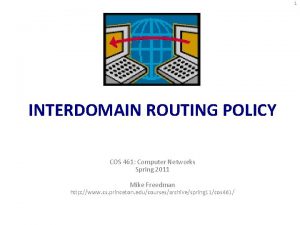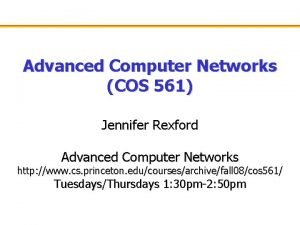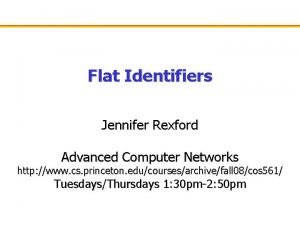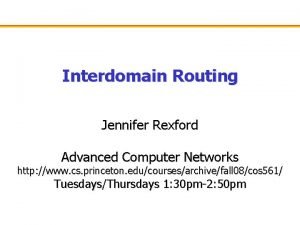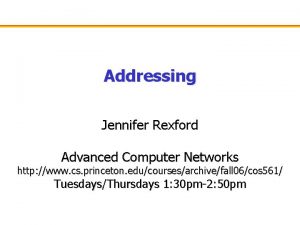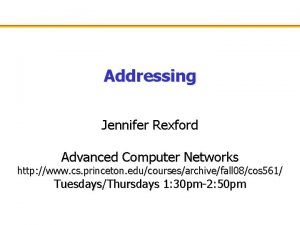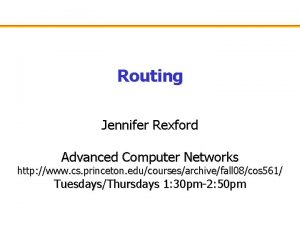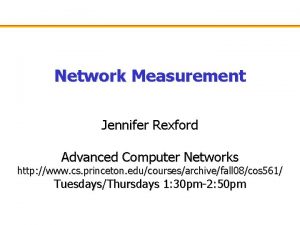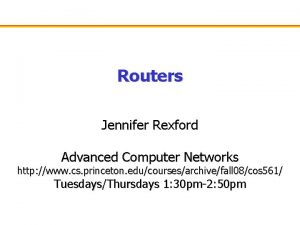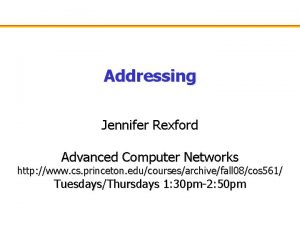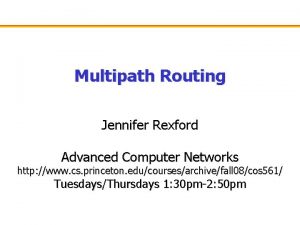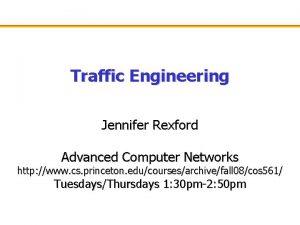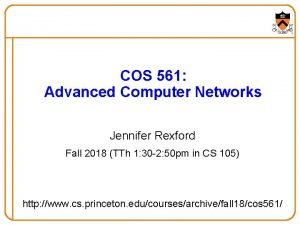Active Networks Jennifer Rexford Advanced Computer Networks http


















- Slides: 18

Active Networks Jennifer Rexford Advanced Computer Networks http: //www. cs. princeton. edu/courses/archive/fall 08/cos 561/ Tuesdays/Thursdays 1: 30 pm-2: 50 pm

Syncing Up on the Class • My apologies for missing last week – Stuck in Thailand due to airport closures – Thinking of becoming a coup chaser • Making up the missed content – Combined two classes into one (for Thursday) • Readings: three short 4 -6 page position papers – Make-up lecture during exam period • So, two classes during exam period – One to present course projects – One as a final wrap-up class for the semester • Are folks free Thursday December 18? • Or mid-to-late afternoon Wednesday December 17?

Nice Quotation from the Tennenhouse Paper There is presently a disconnect between what users consider to be “inside” the network and the practitioner’s perspective, which is somewhat restricted. For example, web browsers allow users to interact with what they perceive to be “the network” without distinguishing among the many routers, domain name servers, and web servers that conspire to provide the service. It may be time for practitioners to reevaluate their abstractions and start thinking about the network at a higher level.

Passive Networks • Dumb store-and-forward network – Smart end hosts implement key functions – Simple routers store and forward packets – Limited network processing (e. g. , routing, forwarding, buffering, and packet scheduling) • Packet header used in a simple way – Common, standardized format – Causes one of a small set of operations to occur – Packet forwarded or dropped based on those rules – Network (largely) ignores higher-layer headers

Active Networks • Packet == data + code – Smart hosts, as before – Active nodes that can execute code on the data – Active packets that carry code to active nodes • Postscript analogy – Contains both your data, and the program the printer runs to print your data • Definition: Active networks allow an individual user, or groups of users, to inject customized programs into the nodes of the network.

Motivation for Active Networks • High-level goal – Leverage computation in the network • User pull – Automatically adaptive streaming – Data aggregation to reduce data volumes – Computation closer to users to reduce latency • Industry push – Ad-hoc collection of middleboxes emerging – Replace with generic, multi-purpose active nodes – Otherwise, proliferation of active components will happen anyway, without any common framework

Motivation for Active Networks (Continued) • Big mismatch in rates of innovation – Applications change quickly (e. g. , Web, P 2 P, IM) – The network changes slowly • Deploying new network technology is hard – Delay for standardization (at the IETF) – Additional delays for vendors to implement and service providers to deploy the new technology • Better to decouple services from hardware – Minimize the amount of global agreement – Load new services on demand

Motivating Examples • Customized packet-drop policy – User watching video stream (MPEG) – Congestion leads to bandwidth limits – Drop selectively the B frames – Requires application-specific intelligence • Other examples – Forward error correction: adapt to loss rate. – TCP-SYN filtering – Web caching – Reliable multicast (or any multicast) – Support for mobility

Enabling Technologies for Active Networks • Component-based software engineering – Building blocks for composing software • Code mobility (e. g, . Java) – Though previously between end hosts, not network nodes – Innovation in safe and efficient code mobility • Field-programmable gate arrays (FPGAs) – Enabling higher speed of packet processing • Research in programming languages – And PL folks’ interest in networking

Two Models of Active Networks (ANs) • Active networks are active in two ways – Switches run code on data flowing through them – Individuals can inject programs into the network • Programmable switches: discrete ANs – Separation of program loading and execution – E. g. program loading only by network operator – Packet is demultiplexed to the right program • Capsules: integrated ANs – Every packet is a program, and carries its code – Perhaps in a restricted programming language

Three Parts to an Active Network • Execution environment – Virtual machine with access to node resources – General, Turing-complete vs. restricted models • Active applications – Provide an end-to-end, customized service – Load code on to the routers to program the VM • Node operating system – Support multiple execution environments at once – Provide safety between execution environments

Example: Capsules • Capsule = code + data – Extension of IP packet format • Type that identifies the code that should handle the capsule – E. g. , may indicate a Java class • Code runs in transient execution environment – Destroyed when the capsule evaluation ends • Active storage – Capsules can leave information behind in a node’s non-transient storage for subsequent capsules • External methods cached on the node

Concerns: Security, Safety, and Performance • Protection – Can my service damage yours? – Need to run code in a sandbox • Resource management – Can my service consume arbitrary resources? – Need careful control over resource allocation • Performance – Can my program complete quickly enough to avoid introducing excessive latency? – Need to limit the complexity of the programs – … or run them only on lower-speed links

Safety and Security • • • Programs ensured to terminate Limited amount of resources consumed Type-checked programs Basic error handling No interference due to concurrent execution

Efficiency and Performance • Running programs on packets – Questionable on higher-speed links – E. g. , where you have just a few nsec per packet • Feasible at the edge (e. g. , 100 Mbps, 1 Gbps) – Firewall, NAT, shaper, proxy, intrusion detection • Feasible for control plane in the core – Running routing protocols • Computer architecture advances help – Faster conventional processors – Network processors and FPGAs – Multi-processor cores

Stepping Back • Was active networks a success or failure? – General idea of computation and services inside the network? – Need for a principled approach to middleboxes, and a blurring of router vs. general network node? – Specific mechanism of packets carrying code? • Devil in the details – What granularity: packets vs. flows – When is code loaded: on demand vs. in advance – Who programs: user vs. network operator

What’s the Difference Between Active Nets and… • Middleboxes? – Firewall, NAT, proxy, gateway, shaper, transcoder • Overlay networks? – Planet. Lab, RON, Akamai, etc. • Programmable, virtualized infrastructures? – Planet. Lab, VINI, and GENI

Discussion • Who should write the programs that run on the active switches? – End users? – Folks offering services? – Network providers? • What programming environment? – Specialized secure, safe, and application-specific languages and operating systems? – Conventional platforms (e. g. , Linux as in Planet. Lab)?
 Assembly language instruction
Assembly language instruction Gao rexford conditions
Gao rexford conditions Datagram networks
Datagram networks Backbone networks in computer networks
Backbone networks in computer networks Http computer networks
Http computer networks 3 to 8 decoder truth table
3 to 8 decoder truth table Active transport
Active transport Primary active transport vs secondary active transport
Primary active transport vs secondary active transport Http //mbs.meb.gov.tr/ http //www.alantercihleri.com
Http //mbs.meb.gov.tr/ http //www.alantercihleri.com Siat.ung.ac.id
Siat.ung.ac.id Computer architecture
Computer architecture Advanced topics in computer science
Advanced topics in computer science Advanced computer graphics
Advanced computer graphics Advanced computer forensics
Advanced computer forensics Fastbloc
Fastbloc Crc in computer networks
Crc in computer networks Crc in computer networks
Crc in computer networks Traffic management in computer networks
Traffic management in computer networks Tanenbaum
Tanenbaum

